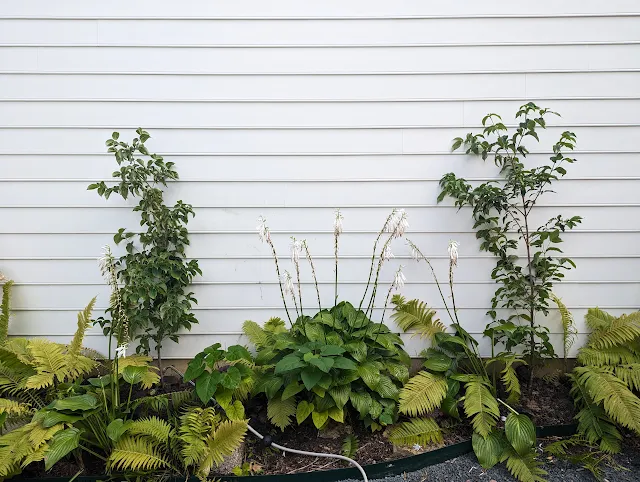Kousa Dogwoods - Two Planted For Espalier - September 2023
Fall planting is here. At least...for me it is. I have two real gardening/planting seasons: Spring - when I can't help myself and get busy in the garden/at the garden center/at the Morton Sale. And then Fall - when I divide and transplant and buy things that go on end-of-season sales. This is the first planting of that 'fall planting' period and is something that I've been thinking about for years. And, finally did something about it.
I'm talking about the northside of our garage, where we get full shade and have a narrow, foundation bed that borders the bluestone chip path that leads to our backyard. All the way back in 2018, I started posting about what to do with this area in terms of trees and shrubs. There are really two parts that *could* be addressed. First..against the house to sort-of soften-up the large, white, blank wall. And, then (potentially) against the property line to provide a sense of 'privacy' or screening from the driveway next door.
When I say full shade, I really mean full shade. Our house blocks out most of the sun, so I've been thinking about/looking at various trees and shrubs that thrive in shade. That's been a big part of the 'why' that I haven't planted anything. The other part is that I had not found the *right* things to plant. Last April (2022), I posted about dogwoods. And how I thought they might work in this spot. I also showed how the construction next door really revealed the big, blank, white wall that is the side of our garage. I'm choosing to consider this an opportunity, not a problem.
Here's a photo from that post in April 2022 that shows the big blank canvas:
A lot of space - in all directions but OUT - to fill up. What does a guy do in a situation like this? Find a couple of trees that can BOTH tolerate full shade AND...do well when they are trained in espalier.
This Summer, I narrowed-in on dogwoods for this spot. I have a Pagoda Dogwood in the back - that's a native tree. In that post, I talked about what I had learned about dogwoods - and their differences. The most common dogwoods are either Kousa Dogwoods or Florida Dogwoods. Those are the two that you see in nurseries around here. I linked to this post that describes the differences. Florida Dogwoods are the ones that have been around a while and are more common. Kousas are newer. And...better. Here's a blurb on Kousas:
Cornus kousa has gained more popularity over recent years, particularly because of its resistance to dogwood anthracnose. The kousa dogwood tends to have leaves that are a bit smaller than the leaves of the florida; also, the blossoms appear a little bit later in the spring and are somewhat smaller, with the white petals having a slightly greenish appearance. The kousa dogwood is somewhat more drought tolerant than the florida.
(emphasis, mine)
Kousa is more disease resistant and drought tolerant. That's enough for me.
But, I knew this info 18 months ago. Why did I finally buy some Kousa Dogwoods? Because I found a deal. For $14.99 each, I brought home two very small Kousa Dogwoods. Here they are below - showing a (mostly) upright form, some immature branching and thin trunks. Dare I say....perfect for espalier.
I dug a couple of holes - spaced five feet from each end and planted these two Kousa Dogwood trees right up against that big, blank, white wall. Here, below is the first one going in:
Thus...for now, I've done nothing to them in terms of shaping and training. I've learned that it is not a good idea to prune a tree this late in the season as it will stimulate some new growth that might not harden off prior to Winter. So...for now...I'm leaving these things as-is. I'll limb-them-up in late Winter/early Spring.
21. Plant trees. But, think about another large caliper one. Or...more interesting ones from Morton sale. Don't get lured by the orange big box store varieties. Unless they're for espalier or a deal you can't resist.
This is now the 13th and 14th tree planted (yes...calling two trees planted despite it being volunteers) of the year and 90th and 91st overall. 12 is the average I've maintained over the years.
We (now) have 65 of 91 trees that we've planted. 71.4% success rate over seven years.
91 trees planted/7 growing seasons = 13 trees on average planted each season
65 trees alive/7 growing seasons = 9.28 trees on average survive each season.
1. Flowering Pear in backyard on north side.
3. Japanese flowering cherry
4 and 5: 2 Lindens that I espalier'd and placed by the south fence line near our kitchen windows.
7. Nat's Saucer Magnolia in our front yard
2018 (17 planted. 6 Dead):
14, 15, 16, 17, 18, 19, 20, 21. These Frans Fontaine Hornbeams.
22. A replacement Chanticleer Pear tree (3" caliper) out front by our garage
25. Our replanted/replacement Dawn Redwood. Same spot as the first.
26. This teeny-tiny Bald Cypress that I planted in the front yard, in between our driveway and our neighbor to the north.
33. My new Weeping White Spruce that will only grow about 4' wide placed near the fence line alongside the espalier'd Lindens.
35. T
46. A small Northern Red Oak tree - our first Oak tree planted.
47. A 'decapitated' Lavender Twist Weeping Redbud that I planted on a whim.
49. A tall(ish) London Plane tree that suffered some transplant and frost shock, but seemed to recover.
1. [This says 'planted', but there are two volunteers on here that aren't 'technically' planted in 2023, I just counted them in 2023.]↩











Comments
Post a Comment
Be nice to each other here.